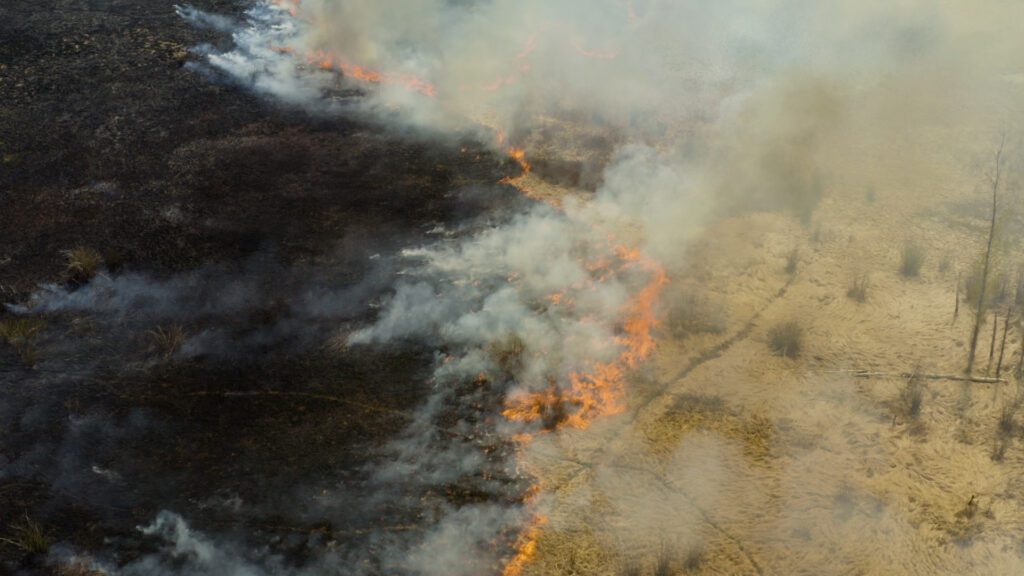There are multiple histories and perspectives of fire governance in British Columbia’s history. From Indigenous-led fire stewardship when fire was respected, to the suppression of fire led by emergency response organizations, the way fire is governed and viewed has evolved dramatically in the last century.
Historical policies of fire suppression and exclusion imposed by colonization have resulted in a build-up of forest fuels, an increase in fire risk, decreased forest resilience and an interruption of Indigenous fire stewardship cultural practices.
As wildfire seasons become increasingly more challenging and catastrophic, the need for new fire governance models that enable coexistence with fire is clear. Examining how fire governance has changed over time can help identify opportunities for meaningful, proactive transformation as we face a future where fire will continue to impact people, communities and the landscape.
A study conducted by UBC researchers from 2018 to 2021 examined views of fire governance through interviews with 19 wildfire and forestry experts and a review of over 150 documents. Themes include worldviews of fire, decision-making processes and power, legislation, and drivers of change. The interviewees emphasized the importance of Indigenous decision-making power in the future of fire governance in BC.
Research Study
The research study was conducted by Drs. Kelsey Copes-Gerbitz, Shannon M. Hagerman, and Lori D. Daniels from 2018 to 2021, and offers valuable insights into BC’s history and relationship with fire. By analyzing historical records, Indigenous knowledge, and contemporary practices, the study highlights the complex interplay between environmental factors, cultural practices, and policy decisions that have shaped BC’s approach to fire management over the years.
Insights from the study are captured in an article that was published in March 2022 titled Transforming Fire Governance in British Columbia, Canada: An Emerging Vision for Coexisting with Fire.
An infographic visually displaying this complex information was developed by a team from the BC Wildfire Service and the First Nations’ Emergency Services Society (FNESS) in 2023 in collaboration with Drs. Kelsey Copes-Gerbitz, Shannon M. Hagerman, and Lori D. Daniels. Visit the History of Fire web page of the Cultural Burning and Prescribed Fire website to learn more.

BC’s Evolution of Fire Governance
BC’s history of fire governance can be divided into distinct eras, each characterized by its objectives and approaches to fire management.
Time Immemorial: For Indigenous Peoples, fire has been a tool for stewardship and renewal since time immemorial. Indigenous Peoples across BC have long understood the importance of fire in maintaining healthy ecosystems and cultural landscapes.
1912–1976: During this period, fire management in BC was largely focused on prevention and suppression, as the public viewed it as destructive. The Ministry of Forests emerged as the primary authority responsible for fire management, with a focus on protecting timber supplies and preventing unwanted fires.
1976–1995: The 1970s saw a shift towards more research-based approaches to fire management, with the establishment of the Research Branch within the Ministry of Forests. Efforts were made to better understand fire ecology and behaviour, leading to more nuanced approaches to fire management. It was viewed as a natural event, integral to sustainability.
1995–2017: In the late 20th and early 21st centuries, BC faced increasingly severe wildfires, prompting a reevaluation of fire management strategies. The BC Wildfire Service emerged as the primary emergency response agency, working alongside Indigenous communities, local governments, and other partners to manage wildfires more effectively. The public shifted to viewing fires as unwanted and there was a significant focus on suppressing fires entirely.
2017 & Beyond: Recent years have seen a growing recognition of the importance of shared stewardship and Indigenous leadership in fire management. Efforts are underway to integrate traditional Indigenous fire practices into Western fire management strategies, fostering greater resilience and sustainability in the face of wildfire threats. The current view of fires is that they are inevitable but that with the right approach, we can coexist with them.
Reconciliation Driving Change
One of the most significant shifts in BC’s fire governance has been the recognition of reconciliation with Indigenous communities as a driving force for change. Indigenous stewardship practices, once marginalized, are now being embraced as essential to fire management.
Public perception of fire has also evolved from viewing it as a purely destructive force to recognizing its role as a natural and inevitable part of many ecosystems. This shift in perception has led to greater acceptance of controlled burning and other proactive fire management strategies.
Decisions about fire management are now made collaboratively with input from a wide range of interested parties, including Indigenous communities, landowners, industry, and government agencies. This shared stewardship approach recognizes that effective fire management requires collective action and cooperation.
Respecting Fire

But further change is still needed. The research study showed that respect for the role of fire must be at the heart of BC’s evolving fire governance. Whether through Indigenous stewardship, controlled burning, or collaborative partnerships, fire can be both beneficial and necessary for maintaining healthy landscapes.
As we look to the future, we have a clear opportunity to learn from the insights gained through research and embrace the principles of shared stewardship. By working together to put fire back on the landscape in a controlled and safe way with the direction and knowledge of Indigenous Peoples, we can build a more resilient province.
You can learn more about the work the BC Wildfire Service and Ministry of Forests are doing to enable and promote the use of cultural burning and prescribed fire:
To learn more about cultural burning, prescribed fire and shared stewardship, visit https://prescribedfire.ca.
